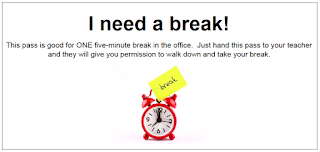Today I facilitated a professional learning opportunity with about 10 teachers working with students grades kindergarten through 4th grade. It was a fun and busy day of learning with fabulous discussions. The content was developed utilizing online resources as well as content from Visible Learning for Mathematics (Hattie, Fisher, Frey), Talk Moves (Chapin, O'Connor, Anderson), and Number Talks (Parrish). The books are fabulous, and I would highly recommend a read. In the meantime, feel free to utilize some of the slides from these Google Slides I put together to help guide our work for the morning.
Efficacious Education
Exploring educational practices that at engaging, encouraging, and equitable. https://sites.google.com/view/efficaciouseducation/home
Thursday, January 10, 2019
Sunday, January 6, 2019
Math Talk Moves Resource
This is a quick resource to help teachers remember five of the key math talk moves. The information on the bookmark is based on the information from the book, Talk Moves: A Teacher's Guide for Using Classroom Discussions in Math written by Chapin, O'Connor, and Anderson. It should be noted that there are other talk moves detailed in the book, this is just a resource for five that tend to be particularly high-leverage in my experience. See the PDF version of this resource here.
Saturday, January 5, 2019
SEL and Restorative/Holistic Discipline Notebook
So this is my prize possession as an administrator and something I wish I had spent the time to compile as a teacher-- my SEL/Restorative Discipline Notebook. Using the CASEL framework as a starting point I have taken an assortment of resources and put them into color-coded sections to be able to utilize in the moment when working with students around prosocial behaviors or restorative practices. Below is a brief explanation of what I keep in my binder to give you an idea of what works well for me. I am a big believer in 'making it your own' so this is really intended to give you a starting place to inspire you to create something fantastic that aligns with your school's SEL/PBIS work and is supportive of your students.
Binder Sections:
Binder Sections:
- Copies of Investigation Note Taking and Investigative Protocol
- Pink Tabs (Unrelated to CASEL): Community Resources, Apology Note Templates, Think Sheet Templates, School PBIS Expectation Lessons, and Community Service Menu copies.
- Orange Tabs (color-coded to correspond to CASEL): Self-Awareness Resources and Lessons, Self-Management Resources and Lessons
- Green Tabs (color-coded to correspond to CASEL): Social Awareness Resources and Lessons, Relationship Skills Resources and Lessons
- Yellow Tabs (color-coded to correspond to CASEL): Responsible Decision-Making Resources and Lessons
Some of the Resources I Used to Compile the Binder Content:
- School PBIS Lessons and Materials
- Kelso's and KC's Choice Wheel Materials
- Second Step (District Adopted Curriculum) Materials
- Kids Health Online Articles
- "What To Do When..." Series by Dawn Heubner
- Don't Suspend Me! An Alternative Discipline Toolkit by J. Hannigan
Friday, January 4, 2019
Edutopia Article: Dos and Don'ts of Classroom Decorations
There is such a fine line between classroom decorations that are engaging students in learning and classroom decorations that are distracting students from learning. I am loving this article from Edutopia that outlines some considerations for teachers as they set up their classroom environment. Based in researched best practices, this is a short read with some fabulous pointers!
Read Edutopia Article here.
Read Edutopia Article here.
Tuesday, January 1, 2019
Break Cards
Break cards can be a helpful tool for students who have big reactions or escalations due to anxiety or work avoidance. It can give them an appropriate "out" before a big blow up and allow them a reflective or cool down moment before jumping into their work. For some students the break can be enough to reset them and get them ready for the task at hand, but often times break cards work best with additional interventions such as modifications to length, complexity, or intensity of classwork.
Subscribe to:
Comments (Atom)




